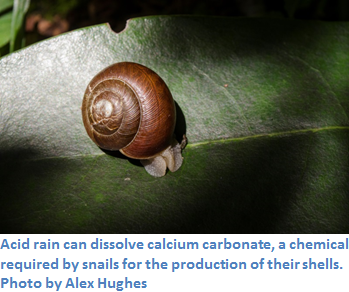When travelling through the park, numerous varieties of plants can be spotted at almost every corner. The vegetation varies by multiple characteristics, including size, shape, leaf type, blooming patterns (if it blooms at all!) However, one common trait binds them together – a majority of the plants in Great Smoky Mountain National Park live and prosper in acidic soil.

What is Acidic Soil?
To answer this question, we must first understand the concept of pH. pH is a measurement of the relative concentration of hydrogen ions in a solution, which runs from 1 to 14. Solutions with a pH of 7 are neutral, neither acidic nor alkaline. Solutions that rank below 7 on the pH scale are acidic, such as soft drinks and vinegar. Solutions that rank above 7 on the pH scale are alkaline, such as toothpaste and bleach. The pH level of fresh, moist soil can vary over time and location, but generally soils in areas of high rainfall have low pH levels, and soils in areas of low rainfall have high pH levels. The yearly rainfall in Great Smoky Mountains National Park ranges from 55 inches to 85 inches. This high level of precipitation leeches away nutritional ions from the soil, including calcium, magnesium, potassium, and sodium. This results in the concentration of hydrogen ions in the soil increasing, which lowers its pH level.
| Plant | Preferred pH Range |
|---|---|
| American Holly | 5.0-6.0 |
| Azalea | 4.5-5.0 |
| Beech | 5.0-6.7 |
| Blueberry | 4.0-5.0 |
| Flowering Dogwood | 5.0-7.0 |
| Geranium | 6.0-8.0 |
| Hemlock | 5.0-6.0 |
| Leucothoe | 4.5-6.0 |
| Mountain Laurel | 4.5-6.0 |
| Rhododendron | 4.5-6.0 |
| Strawberry | 5.0-6.5 |
| Sycamore | 6.0-7.5 |
| White Oak | 5.0-6.5 |
| Source: NC State University, Optimum pH Ranges Select Plants | |
How Does Acidic Soil Affect Plants?
Just as different plants prefer different amounts of rainfall or sunshine, different plants can also have different preferences for soil pH. Acidic soil is not always bad. Indeed, the foliage of Great Smoky National Park thrives in moderately acidic soil. However, if soil drops to a pH level below 4, it becomes inhabitable to most plants.
Is Soil pH Changing?
Yes. A soil’s pH changes regularly, as it is affected by rainfall patterns, decomposing organic matter, and bacterial activity in the ground. These fluctuations are slight and usually do not affect what types of flora can grow in the soil. However, industrial actions by human have introduced a stronger, more permanent change to soil pH. Air pollution caused by power plant smokestacks and automobile exhaust fall down from the atmosphere as “acid rain,” named as such due to its acidic properties. Acid rain is the result of these pollutants (mostly sulfate and nitrate) reacting with water to form acids. While regular rain has a pH level between 5 and 6.5, acid rain’s pH can be as low as 1 (the same as battery acid), a dangerous level for even humans to be exposed to. When acid rain falls upon land, it acidifies the soil, lowering its pH. Soils at high elevations within the park are especially prone to acidification, as they receive more rainfall than soils in valleys or other low areas.

How is Wildlife in the Park Affected?
Many animals within the park rely on specific types of plants as their sole food source. Monarch butterflies, for example, only lay their eggs on milkweed, and only eat milkweed while in their caterpillar phase. Milkweed requires a moderately acidic soil to grow, surviving in soil pH levels from 4.8 to 6.8. As with most other plants, it cannot tolerate pH levels below 4. Overly-acidic soil prevents roots from being able to absorb water and nutrients crucial for survival. Long-term exposure to soil below a plant’s acceptable pH range can result in stunted growth and, in extreme cases, death. Gradually, plant diversity decreases as less hardy trees, ferns, and flowers can no longer bear the acidity in their original niches and must either retreat or perish. A cascade of effects follows, as animals higher up the food chain lose their particular food sources. Acid rain can directly affect animals that rely on soil as well. For instance, acid rain can dissolve calcium carbonate, a chemical required by snails for the production of their shells. In lakes and rivers, acidification has a similar effect on organisms. Acid rain that falls on lakes and rivers or drains from nearby soils lowers the pH of that body of water. Lower pH levels can be toxic to fish and other creatures that are acid-sensitive, weakening the food chain for animals that rely on them for sustenance.
What Can be Done?
In small areas, the addition of lime (a chemical present in limestone) can raise pH and provide a temporary answer to the problem of soil acidification. Unfortunately, such results are only local and cannot be used throughout the entirety of the park. The best defense to safeguard biodiversity is to decrease the amount of acid rain reaching the area to begin with, a demanding but ultimately vital solution.
For activities and lesson plans, including some related to this topic, click here.

























